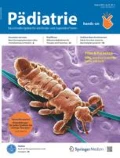Zusammenfassung
Vor noch nicht allzu langer Zeit wurde der Diabetes mellitus Typ 2 als Erkrankung des älteren Erwachsenen angesehen. In den letzten Jahren zeigte sich, dass sich dieser Diabetestyp weltweit immer öfter schon im Jugend- und jungen Erwachsenenalter — parallel zur Zunahme der Adipositas — manifestiert [1, 2, 3]. Welche Screeningmaßnahmen werden bei Risikopersonen empfohlen? Wie unterscheidet sich die Therapie im Vergleich zu erwachsenen Typ-2-Diabetikern?


Literatur
Update: prevalence of overweight among children, adolescents, and adults—United States, 1988-1994. MMWR Morb Mortal Wkly Rep 1997; 46(9):198-202.
American Diabetes Association. Type 2 diabetes in children and adolescents. Diabetes Care 2000; 23(3):381–389.
Schober E, Holl RW, Grabert M et al. Diabetes mellitus type 2 in childhood and adolescence in Germany and parts of Austria. Eur J Pediatr 2005; 164(11):705–707.
Kurth BM, Schaffrath RA. [The prevalence of overweight and obese children and adolescents living in Germany. Results of the German Health Interview and Examination Survey for Children and Adolescents (KiGGS)]. Bundesgesundheitsblatt Gesundheitsforschung Gesundheitsschutz 2007; 50(5-6):736–743.
Zeitler P, Hirst K, Pyle L et al. A clinical trial to maintain glycemic control in youth with type 2 diabetes. N Engl J Med 2012; 366(24):2247–2256.
Reinehr T. Pathophysiologie und Spätfolgen des Diabetes mellitus Typ 2. Monats Kinderhkd 2013; 153:927–935.
Reinehr T. Clinical presentation of type 2 diabetes mellitus in children and adolescents. Int J Obes (Lond) 2005; 29 Suppl 2:S105–S110.
Reinehr T, Kiess W, Kapellen T, Wiegand S, Holl RW. Children with diabetes mellitus type 2 in Europe: an underserved population. Arch Dis Child 2010; 95(11):954.
Diagnosis and classification of diabetes mellitus. Diabetes Care 2013; 36 Suppl 1:S67-S74.
Rosenbloom AL, Silverstein JH, Amemiya S, Zeitler P, Klingensmith GJ. ISPAD Clinical Practice Consensus Guidelines 2006-2007. Type 2 diabetes mellitus in the child and adolescent. Pediatr Diabetes 2008; 9(5):512–526.
Kapadia CR. Are the ADA hemoglobin A(1c) criteria relevant for the diagnosis of type 2 diabetes in youth? Curr Diab Rep 2013; 13(1):51–55.
Reinehr T, Wunsch R. Intima media thickness-related risk factors in childhood obesity. Int J Pediatr Obes 2011; 6 Suppl 1:46–52.
Reinehr T, Schober E, Wiegand S, Thon A, Holl R. Beta-cell autoantibodies in children with type 2 diabetes mellitus: subgroup or misclassification? Arch Dis Child 2006; 91(6):473–477.
Reinehr T, Schober E, Roth CL, Wiegand S, Holl R. Type 2 diabetes in children and adolescents in a 2-year follow-up: insufficient adherence to diabetes centers. Horm Res 2008; 69(2):107–113.
Tuomilehto J, Lindstrom J, Eriksson JG et al. Prevention of type 2 diabetes mellitus by changes in lifestyle among subjects with impaired glucose tolerance. N Engl J Med 2001; 344(18):1343–1350.
http:www.a-g-a.de/Leitlinie.pdf. Guidelines of the German working group on obese children and adolescents. 2013.
Author information
Authors and Affiliations
Additional information
Interessenkonflikt
Der Autor erklärt, dass er sich bei der Erstellung des Beitrages von keinen wirtschaftlichen Interessen leiten ließ und dass keine potenziellen Interessenkonflikte vorliegen. Der Verlag erklärt, dass die inhaltliche Qualität des Beitrags von zwei unabhängigen Gutachtern geprüft wurde. Werbung in dieser Zeitschriftenausgabe hat keinen Bezug zur CME-Fortbildung. Der Verlag garantiert, dass die CME-Fortbildung sowie die CME-Fragen frei sind von werblichen Aussagen und keinerlei Produktempfehlungen enthalten. Dies gilt insbesondere für Präparate, die zur Therapie des dargestellten Krankheitsbildes geeignet sind.
Rights and permissions
About this article
Cite this article
Reinehr, T. Typ-2-Diabetes trifft auch immer mehr Jugendliche. Pädiatrie 27, 19–24 (2015). https://doi.org/10.1007/s15014-015-0409-9
Published:
Issue Date:
DOI: https://doi.org/10.1007/s15014-015-0409-9

